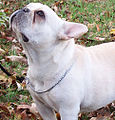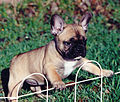Coat Colors? – Them's fightin' words!
Want to start a fight on a French Bulldog discussion list? Bring up the topic of French Bulldog coat colors. There are few other topics more guaranteed to get threads going of 75 or more responses, or more promising of exchanges like ‘oh yeah? Sez you’ and ‘You wouldn’t know medelian genetics if it jumped up and bit you in the face’.
There’s a fairly simple reason for this, actually – complexity. Few if any breeds come in the staggering array of allowable colors and patterns seen in French Bulldogs. Our standard in North America pretty much states ‘except for these few disallowed colors, have at it, dog breeders!’. To be more precise, the American Kennel Club standard for the French Bulldog says –
Acceptable colors – All brindle, fawn, white, brindle and white, and any color except those which constitute disqualification. All colors are acceptable with the exception of solid black, mouse, liver, black and tan, black and white, and white with black, which are disqualifications. Black means black without a trace of brindle.
Read that again, carefully –
any color except those which constitute disqualification
That means that if I can genetically engineer myself a glow in the dark pink Frenchie, I could register and show it.
Night shows would be particularly interesting to show one at, don’t you think?
The European standards are a bit tougher on colors, with the FCI standard stating –
– Uniformly fawn, brindled or not , or with limited patching (pied).
– Brindled fawn or not, with medium or large patching.All the fawn shades are admitted, from the red to light brown (café au lait) colour. The entirely white dogs are classified in “brindled fawn with large white patching”. When a dog has a very dark nose, dark eyes with dark eyelids, certain depigmentations of the face may exceptionally be tolerated in very beautiful subjects.
The FCI standard doesn’t need to list specific DQs (or disqualifications), as their standard has a short, concise list of allowable colors, instead. So, rather than the American standard, which tells us ‘anything other than these few colors is allowed’, the FCI standard says ‘nothing other than these few colors is allowed’.
Over in the UK, the standard says –
Brindle, pied or fawn. Tan, mouse and grey/blue highly undesirable.
Brindle: a mixture of black and coloured hairs. May contain white provided brindle predominates.
Pied: white predominates over brindle. Whites are classified with pieds for show purposes; but their eyelashes and eye rims should be black. In pieds the white should be clear with definite brindle patches and no ticking or black spots.
Fawn: may contain brindle hairs but must have black eye lashes and eye rims.
Reading this, one would assume that ‘cream’, as an ee expression of fawn, would be allowed. One would, however, be wrong. The British French Bulldog breeders are almost completely uniform in their rejection of anything other than what we refer to as ‘Black Masked Fawn’ – those smutty, tan colored dogs, with the clear black masks. Even the masked red fawns and red fawn pieds are still rejected. In fact, the predominance of the red fawn pied dogs we see in North America can be traced to a handful of UK dogs exported to the US, dogs which were sold mainly because their color was not showable in the UK.
These ‘DQs’ might not be specified in the standard, but they are still accepted as the norm – and if I’m wrong about this, and attitudes are changing, I’d love to hear about it.
The issue of cream versus fawn versus black masked fawn is of particular interest to most North American French Bulldog breeders, where the exact method of inheritance is still open to debate. I’ll discuss further on the vagaries of coat color genetics another time.
For now, I’ll leave you with the color example chart I created for Wikipedia, and which you can also find on French Bulldog Z. As I state repeatedly on both sites, these photos and their corresponding color descriptions are listed as examples only, and are open to debate. The only truism when it comes to French Bulldog coat colors is there are more descriptive color names than there are colors, and everyone has their own preference.
It should also be pointed out that some color terms are subjective, with each breeder having their own opinion as to what defines ‘fawn pied’, ‘honey pied’, etc. The examples listed below should be viewed objectively, and are open to debate. In other words, don’t bother sending me snippy letters if you disagree with my descriptions, as I already have a file of about 200 of those. Polite debate, however, is welcomed.
Click thumbnails to see full sized images.
|
|
|
|
|
|
|
|
|
|
|
|
|
|
|
|
|
|
|
|
|
|
|
|
|
|
|
|
|
|
|
|
|
|
|
|
|
|
|
|
|
|
|
|
|
|
|
|
|
|
|
|
|
|
|
|
|
|
|
|
|
|
|
|
|
|

















Are colors that are considered a DQ colors that naturally occur in Frenchies? I always get so perplexed as to why naturally occurring colors that have no obvious link to health problems are considered DQs. Like Particolored poodles? Why are they DQs?
Katie’s last blog post..So. About that poodle.
Yes, they do occur naturally, and there’s no logical reason for them being a DQ other than ‘someone didn’t like them’ when the original breed standards were being written up.
As I mention above, I read an article that theorized that Black and Tan was a DQ because it’s genetically dominant, and the originators of the standard were afraid it would wipe out all other allowable colors in the breed. That’s just silly, in my opinion, but who knows? Maybe they’re right, and without that as a DQ all Frenchies would be black and tan.
Personally, I think the only reason for a color/pattern to be a DQ is if it’s genetically linked to a health condition – deafness, alopecia, etc. That said, I don’t breed DQ colors, mainly because I think they’re indicative of a kind of fad breeding, color only focused breeding program that I find distasteful.
Hi! Just for fun, there’s an excellent (and free) program that can be downloaded from the web called “Phenotype Predictor,” which allows you to input the phenotypes of a sire and dam and predict the phenotype outcome of the litter. It also has the ability to predict the incidence of genetic diseases, if you know whether or not your sire or dam are carriers. Since I consider myself a genetics geek, I’ve spent hours playing the predicting game. I have a litter due on March 3rd, so I can’t wait to see if the predictions are right!
I was looking at your flickr photos, and curious what genetics caused Dexter’s color, so it’s ironic you’re one of the first links on Frenchie colors on google!
I’m assuming that the pale creams are likely an ee dilute of the fawn gene? It looks like he has a black nose, so I assume so.
And also, is the ‘mouse’ color in the standard the dd blue gene? I know that many standards call dd bb dogs ‘mouse’ which is why I’m asking, since it doesn’t look like light noses (Liver and blue) are disallowed? I have never SEEN blue or livers shown personally, which is why I’m curious if it’s dd bb (‘Isabella’ in some breeds) that the standard calls ‘mouse’.
I’m not a Frenchie person, but have long considered being owned by a show Frenchie. Before choosing my Cardigans, I long considered the bat-eared Frenchie as ‘my breed’, but as a student didn’t think they would fit in my budget at the time. I’m still interested in maybe getting a show Frenchie ‘someday’. They are such fun dogs! For now I just happened to stumble on the flickr pages of your ADORABLE dogs, and am suffering a bad case of “Oh my they are CUTE!” 🙂
Whoops, going to the AKC site, and re-reading the standard I see my sleeplessness made me out to be a moron, as the standard, and your above text boldly states livers are not allowed 😉
You also added that the standard refers to dd blue as ‘mouse’. Sorry! it’s 3am and I have a sick 3 year old keeping me on ‘kidlet watch’ tonight 😉 I’ve been looking at Crufts photos while I’m awake.
This is simply a reminder, that I should never, ever try to read, type, or even think when I am sleep deprived *G*
If a puppy is going to have ticking, when does that ticking normally show up. I bought a puppy with beautiful white coat base and red pied spots…but I’m beginning to worry about ticking. Is ticking red or black? He has a spot of red here or there, two or them..but again, I’m just worried. You can tell his skin underneath is freckled black, but his coat is white on top of the black, except for the big red pied spots. Just wondering…
Hi Becky –
Ticking can take a few months to show up. Remember, it’s a rare pied dog who doesn’t have a few freckles on their coat – it’s excessive ticking that’s frowned on. Of course, if your dog wasn’t bought for the show ring it really make no difference. I actually think ticking can be cute on a pet dog! 🙂